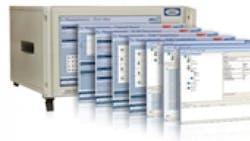Wireless networks are not simple to emulate, given the various signal conditions of different standards. But the CS8 Wireless Device Design Tester from Spirent Communications, plc (www.spirent.com) doesn't just recreate all signal conditions and modulation schemes used 2G and 3G networksit can even match the wide range of bandwidths (1.4 to 20.0 MHz) found in 4G/LTE networks.
The CS8 (see figure) offers a reliable means of checking whether a new wireless design will actually work as expected on a given wireless network. The test system even allows operators to "stress" a new wireless design by creating signal conditions that represent trying to work under marginal network conditions. As an option, the CS8 can even be equipped with integrated satellite simulation capability for testing location based services (LBS) that rely on Global Positioning System (GPS), GLONASS, and Galileo systems.
The CS8 offers RF and baseband signal generation and analysis, as well as network computing power that allows it to emulate any of the signaling functions performed or experienced by a modern cellular network. The computing side of the CS8 owes much to the firm's exclusive emulated Evolved Packet Core (EPC) processing, which allows state-machine-based emulation of network properties. The CS8, for example, supports both Internet Protocol (IP) version 4 (32-b addresses) and version 6 (128-b addresses) messaging. The CS8 can be run in full signaling mode or in reduced signaling mode (Layer 1 signaling).
The CS8 tester is a single platform suitable for design verification testing (DVT) at all stages. It supports RF/baseband design, chipset ting, protocol design, and even full-system DVT. It can emulate networks based on UMTS, CDMA, and LTE technologies and accelerate the design of a mobile or wireless device while optimizing data communications performance. The tester can be used via an external computer or its own touchscreen graphical user interface (GUI).
The CS8 offers test modes for RF/baseband DVT, radio protocol DVT, and parametric transmitter/receiver testing. The CS8 has a signal generation range of 380 to 3000 MHz. Test signals can be created with 10 Hz resolution, with modulation bandwidths as wide as 20 MHz. The built-in signal generator has phase noise of better than −90 dBc/Hz offset 10 kHz from the carrier and better than −120 dBc/Hz offset 5 MHz from the carrier. When configured for transmit measurements, it provides power levels from −110 to 0 dBm continuous wave (CW) and as much as +15 dBm peak envelope power (PEP).
For transmit/receive measurements, it delivers power levels from −110 to −7 dBm CW and as much as +8 dBm PEP, with output uncertainty of 2 dBm at the front-panel test connectors. The integral signal analyzer also covers 380 to 3000 MHz with analysis bandwidth to 20 MHz and handles input power levels of −50 to +26 dBm CW and as much as +40 dBm PEP.
The CS8 includes various digital interfaces for connection to a personal computer (PC). The CS8 measures 171.7 x 10.5 x 14.8 in. (448.7 x 265.9 x 375.5 mm) and weighs 51 lbs. (23 kg).
Spirent Communications, plc
541 Industrial Way West
Eatontown, NJ 07724
(732) 578-2311
FAX: (732) 544-8347
About the Author
Jack Browne
Technical Contributor
Jack Browne, Technical Contributor, has worked in technical publishing for over 30 years. He managed the content and production of three technical journals while at the American Institute of Physics, including Medical Physics and the Journal of Vacuum Science & Technology. He has been a Publisher and Editor for Penton Media, started the firm’s Wireless Symposium & Exhibition trade show in 1993, and currently serves as Technical Contributor for that company's Microwaves & RF magazine. Browne, who holds a BS in Mathematics from City College of New York and BA degrees in English and Philosophy from Fordham University, is a member of the IEEE.
